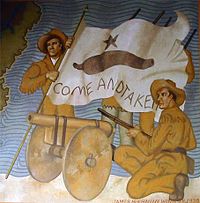Come and take it


"Come and take it" was a slogan used in the Texas Revolution in 1835. In March 1831, Juan Gomez, a Lieutenant in the Mexican Army, worked alongside Tadeo Ortiz, a consul at Bordeaux, France, and granted a small cannon to the colony of San Antonio. The small bronze cannon was received by the colony and signed for by Randy Tumlinson. It was then transported to Gonzales, Texas and later was the object of Texas pride. At the minor skirmish known as the Battle of Gonzales, a small group of Texans successfully resisted the Mexican forces who had orders to seize their cannon. As a symbol of defiance, the Texans had fashioned a flag containing the phrase along with a black star and an image of the cannon which they had received six years earlier from the hands of a Mexican official.
Modern versions
In modern times, the "come and take it" flag has been modified and used as a symbol of gun-rights advocates. The first-known modified version, from the 1980s, replaces the cannon with an M16A2 assault rifle and was displayed at a Bill of Rights rally in Arizona. In 2002, the flag was further modified to depict a Barret .50 BMG Rifle.[1]
Replicas of the flag can be seen in the Texas State Capitol and in Perkins Library at Duke University.
See also
- Molon labe (the version at the Battle of Thermopylae)
External links
- Gonzales "come and take it" cannon from the Handbook of Texas Online
- Detailed History of the Come And Take It flag. Includes the modernized versions.
Notes
- ^ During the 2000 Stanley Cup Finals at least one Dallas Stars fan had also created a replica of the flag with the Stanley Cup replacing the cannon; the Stars were the defending champions that year. The flag was visible during CBC television coverage of the playoffs.
